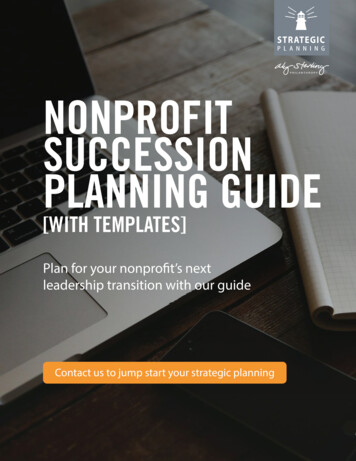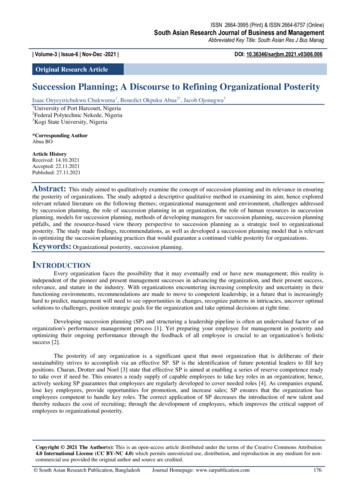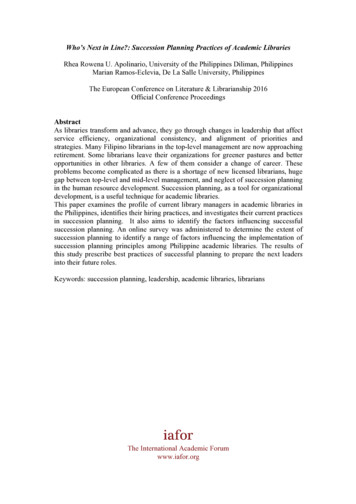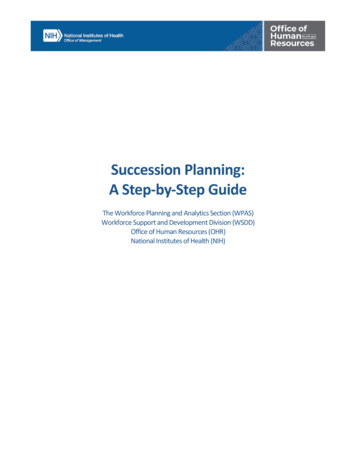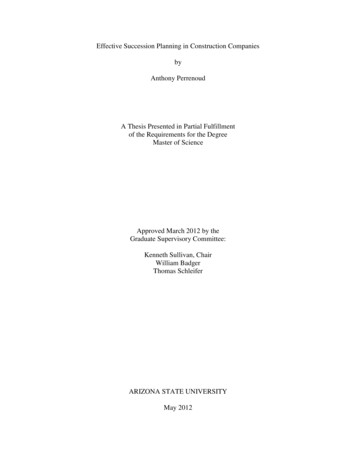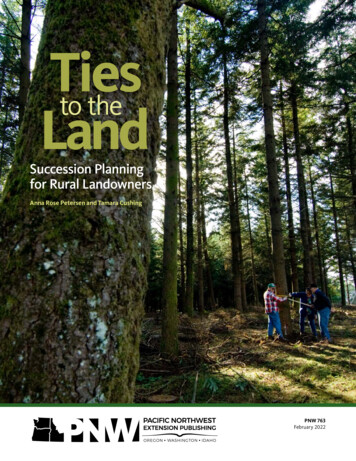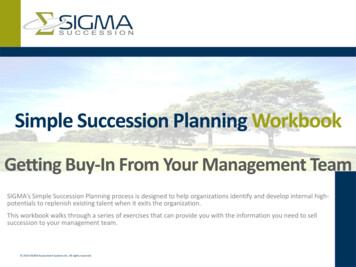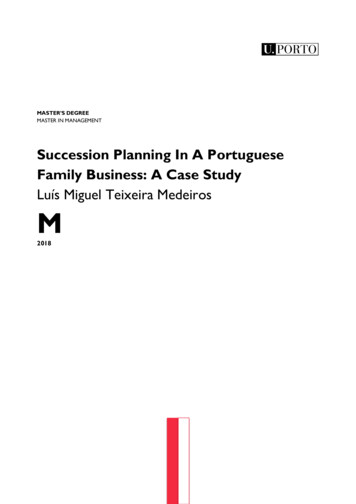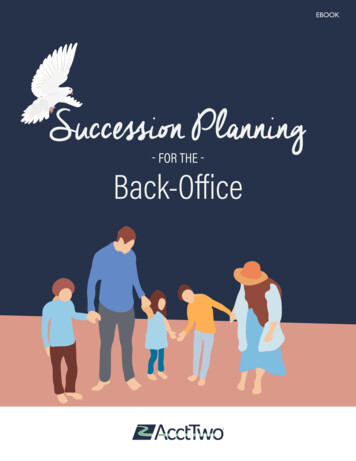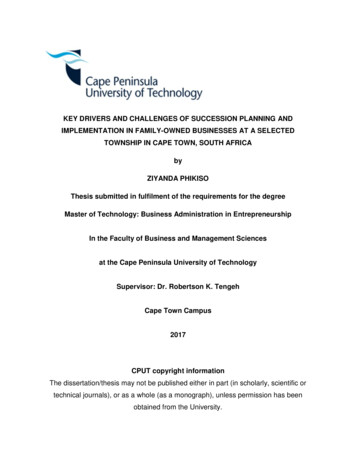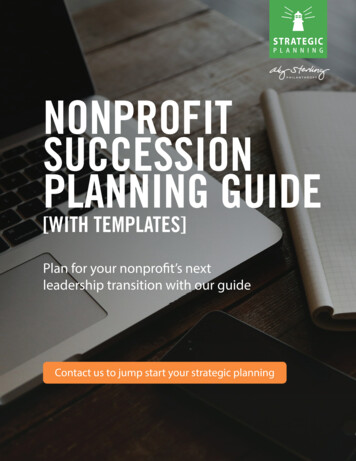
Transcription
NONPROFITSUCCESSIONPLANNING GUIDE[WITH TEMPLATES]Plan for your nonprofit’s nextleadership transition with our guideContact us to jump start your strategic planningPage 1 of 11
THE BASICS OF NONPROFITSUCCESSION PLANNINGWHAT ARE NONPROFITSUCCESSION PLANS?A succession plan is a nonprofit’s outline for how they’ll ensureleadership continuity in the event of a key change in personnelwithin the organization. In this plan, the nonprofit outlines howthey’ll recruit their new leader as well as how they’ll ensuresuccess under the new leadership.WHY ARE SUCCESSIONPLANS IMPORTANT?Without developing a well thought-out nonprofit succession plan,organizations open themselves up to serious performance risk. If theyare unable to find competent leadership to bridge the gap after a keymember departs, there’s also the risk of losing the support of boardmembers and donors.HOW DO THESE PLANSBENEFIT NONPROFITS?If a nonprofit already has crafted a succession plan when a leader makestheir departure, they can ensure a smooth transition as their new leadertakes on their role. Additionally, by spending time planning out howthey’ll make their replacement, the nonprofit can avoid bringing on anunqualified leader.Learn more about creating an executive transition planPage 2 of 11
LEADERSHIP ROLES THATREQUIRE A NONPROFITSUCCESSION PLANExecutive DirectorNonprofit succession plans are most commonly developed to ensure a smoothtransition after the departure of the executive director of an organization.Since so much of a nonprofit’s reputation among the giving community hinges onhow people perceive the leadership strengths of their executive director, havinga fail-safe plan in place can be crucial to making it through the switch from oneexecutive director to the next.Board MembersNonprofits should also have succession plans on hand to help replace departingboard members. You can develop individual plans for different seats on the board,or a comprehensive plan for all board members.Because board members themselves tend to be high contributors as well as keynetworking resources, it’s important to plan for how your organization will overseetheir departure.High-Level StaffYour executive director isn’t the only position of your staff for which you shouldhave a succession plan. High-level positions such as your development directoror major gift officer can also benefit from developing these plans.The success of your nonprofit depends upon many individuals working togetherin harmony, and for this reason your team should never risk being unpreparedfor a staff transition.Strengthen your nonprofit leadership succession planPage 3 of 11
UNDERSTANDING THE DIFFERENTTYPES OF LEADERSHIP SUCCESSIONFOR NONPROFITSLEADERSHIP PLANNINGOne type of succession plan that nonprofits develop is strategic leadershipplanning. In this type of plan, organizations map out how they’ll foster talentinternally and develop staff members into future leaders.With such a high turnover rate in nonprofit sector employment, retainingexperienced staff members is one of the biggest challenges nonprofits can face.With strategic leadership planning, organizations craft a long-term successionplan to ensure continued success.EMERGENCY DEPARTUREIn an emergency departure succession plan, nonprofits outline how they’llreplace key leaders in the event that they unexpectedly leave the organization.This may be the result of a termination, resignation, or death that results in aleader quickly vacating their position.To avoid having a prolonged absence in the leadership role, nonprofits craftemergency departure plans to map out how to bridge the gap as quickly aspossible while still ensuring the right new leader is brought on.PLANNED DEPARTURESuccession plans for a planned leadership departure are crafted to ensure thatlong-awaited leadership transitions are handled as carefully as possible.A planned departure may anticipate a retirement, a temporary sabbatical, or amaternity/paternity leave and are typically announced at least 1-3 years in advanceof the role being vacated. Planned departure succession plans typically have thehighest degree of oversight from the individual leaving the leadership role.Learn more about nonprofit fundraising strategy with our tipsPage 4 of 11
LAYING THE GROUNDWORK FOR YOURNONPROFIT SUCCESSION PLANIdentify/Define Role?Personnel Needs?Turnover Risk? IDENTIFY AND DEFINE LEADERSHIP ROLESAs you develop your nonprofit’s succession plan, one of the first things you shouldaddress is your understanding of each leadership role at your organization.Without a clear definition of each position as well as an in-depth understandingof the demands of each role, you risk misunderstanding what is needed for theseleaders to be successful.Your succession plan could be incredibly extensive, but without a fact-basedassessment of the responsibilities and challenges taken on by those occupying theposition(s), you can’t ensure that your plan will find the right new leader for your team.Page 5 of 11
ASSESS PERSONNEL NEEDSOne of the best ways to understand the role that your succession plan addressesis to engage with current personnel and ask for their take on the demands of theleadership position.Your team can interview current and past occupants of the role as well asanyone who works directly with the individual currently in the position.In addition, take this as an opportunity to assess strengths and challenges thatthe current (or most recent) occupant has faced. Can your nonprofit considertheir tenure a success, or is this leadership change an opportunity for reorientingthe role? DETERMINE TURNOVER RISKIf the role your succession plan is designed to address is still occupied without aplan for departure, your team should make an assessment of the turnover risk forthe position.Do you expect the current occupant to depart from the role with the year?Within 3-5 years? At this point, it’s important to determine how long youexpect the position to remain under the same leadership.By making this assessment, your team can get a better idea of how to structurethe timeline of your succession plan as well the amount of time you’ll have tomount an executive search process.Discover more about nonprofit succession planningPage 6 of 11
CULTIVATING FUTURE LEADERSFOR YOUR NONPROFITSINGLE OUT LEADERSHIP PROSPECTSAs you plan for the future, who on staff does your team anticipate would make asuccessful transition into the role?Since preventing excessive staff turnover is one of the key challenges nonprofitsface, promoting from within can be an excellent way to maintain consistency amongyour staff as individuals transition out of leadership roles.During the development of your succession plan, your team can meet with theseleadership prospects and discuss their interest in eventually taking on the role. Do theyseem committed to remaining a part of your nonprofit in the long term?At this juncture, your nonprofit should also evaluate how equipped these prospects areto take on the role in the future. Ask yourselves: Do they need additional training or education? Could they benefit from mentorship from the current individual in the role? Are there multiple individuals primed to transition into this position?As your nonprofit finalizes the succession plan, it’s best to have several qualified internalprospects for the role in question so that your team will have options if circumstanceschange down the line.Page 7 of 11
GROW THE LEADERSHIP ROLE IN QUESTIONYour nonprofit’s succession plan shouldn’t just be about finding a replacement for adeparting leader: it should also be an opportunity to evolve the role in question.Even if the current occupant of the position is successful by all metrics, thatdoesn’t mean that the role itself is equipped to meet the needs of your growingorganization.As your team crafts its succession plan, determine how the new leader in the rolecould do more for your nonprofit.Determine the qualities you’re looking for in a leader occupying the new-andimproved version of the leadership position. Ask yourselves: What circumstances have changed since the current leader took on the role? How do leaders at equivalent organizations compare? Can continuing challenge points in other leadership roles be absorbed into theupdated position?Once you assess the ways in which your nonprofit would like to see the positiongrow, your team can incorporate that into how you evaluate leadership prospectsduring the search process.Page 8 of 11
ENSURING THE SUCCESS OF YOURNONPROFIT SUCCESSION PLANNONPROFIT CONSULTANTAs your organization crafts its nonprofit succession plan,you might consider hiring a consultant to guide the processfor your team.Typically, the development of succession plans fallsunder the strategic planning umbrella of nonprofitconsultation services.Not only will a consultant offer expert insight, they can alsotake a step back and provide a measured perspective intohow your team can leverage this plan to strengthen yourorganization’s overall strategy from the top down.ROBUST ONBOARDINGAnother way your nonprofit can ensure the success of yoursuccession plan is to thoughtfully onboard your new leader.During this time, you’ll give the individual the trainingand tools they need to thrive in the position.For individuals new to your organization, you may alsoconsider introducing them to aspects of your organization’sculture and traditions that are necessary for themunderstand in order to be successful team leaders.Page 9 of 11
PERFORMANCE CHECKPOINTSFinding the right candidate for your vacant leadershipposition is just half the battle.To ensure continued success, introduce performancecheckpoints to assess how well the leader is adapting tothe transition.Don’t just look for indications that the individual isstruggling in their role, but also determine where theyflourish. In these evaluations, you can assess how toimprove their performance as well as how to translate theirstrengths into other aspects of your organization.Page 10 of 11
NONPROFIT SUCCESSIONPLAN TIMELINESUCCESSION PLANDEVELOPMENTMonth 0-12: Develop Succession PlanThe succession plan development process should take at least 12months. For this reason, it’s integral that your team doesn’t wait until aleadership position is vacant to craft your plan. However, it’s never toolate to start planning.Month 12-18: Position RecruitmentPOSITIONRECRUITMENTAfter the succession plan is developed, the recruitment process typicallytakes about 6 months to conduct. This includes identifying prospects,accepting formal applications and assessing preliminary candidatesbefore interviews.Month 18-21: Candidate InterviewsCANDIDATEINTERVIEWSAfter identifying ideal candidates for the position in question, take about3 months to carefully conduct interviews. Remember, you’ll need to holdseveral rounds of interviews to narrow down the candidate pool enoughto make an informed decision.Month 21-24: Position OnboardingPOSITIONONBOARDINGOnboarding should take anywhere between 3 and 6 months beforeyour new leader is fully transitioned into the role. During this time, yourteam can determine whether or not the individual is a good fit for theposition in the long term.
THE BASICS OF NONPROFIT SUCCESSION PLANNING WHAT ARE NONPROFIT SUCCESSION PLANS? A succession plan is a nonprofit's outline for how they'll ensure leadership continuity in the event of a key change in personnel within the organization. In this plan, the nonprofit outlines how they'll recruit their new leader as well as how they'll ensure
